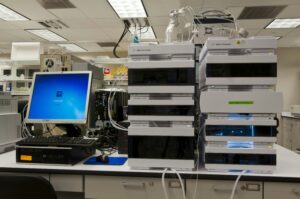
From ancient willow bark remedies to modern aspirin tablets, salicylic acid has long played a crucial role in human health. It is also central to how plants defend themselves against disease. Now, researchers at the University of Cambridge have developed a groundbreaking biosensor that allows scientists to observe, for the first time, how plants utilize this vital immune hormone in their battle against pathogens.
Published in the journal Science, Dr. Alexander Jones’ team at the Sainsbury Laboratory Cambridge University (SLCU) introduces SalicS1, a genetically encoded biosensor capable of detecting and tracking the dynamics of salicylic acid (SA) with remarkable precision within living plants. This development marks a significant advancement in plant biology, offering insights into the intricate balance plants maintain between growth and immune defense.
Understanding Salicylic Acid in Plant Immunity
Salicylic acid is a key regulator of plant immunity, initiating defense responses against a wide array of invaders. Until now, scientists lacked the tools to measure SA with the spatial and temporal resolution necessary to fully understand its role. “Plants keep salicylic acid signaling, which can slow growth, in reserve and carefully activate it when needed. Pathogens like fungi, viruses, and bacteria, as well as pests like aphids, have evolved several ways to suppress SA and weaken plant immunity,” explained Dr. Jones.
“By enabling precise, high-resolution monitoring of SA, SalicS1 gives us a powerful new way to understand the life-or-death battleground that is SA concentration that could ultimately inform strategies to improve crop resilience.” — Dr. Alexander Jones
Utilizing the new biosensor, the research team observed surges of SA accumulation spreading from the site of pathogen invasion into surrounding tissues, offering fresh insights into how plants coordinate local and systemic defenses. Dr. Bijun Tang, the study’s first author, noted, “With SalicS1, we can watch SA as it rises and falls in real time, inside living tissues, and even track how it spreads from cell to cell during infection.”
Implications for Plant Biology and Beyond
The ability to measure SA reversibly and without damaging plant tissues presents exciting opportunities to address long-standing questions in plant biology, particularly regarding how plants deploy SA in response to both pathogenic threats and environmental stressors. Dr. Tetiana Kalachova, whose team at the Institute of Experimental Botany of the Czech Academy of Sciences contributed significantly to the research, emphasized the tool’s potential.
“This tool represents a major step forward in our ability to monitor SA dynamics as plants respond to a wide range of pests and pathogens that manipulate SA levels.” — Dr. Tetiana Kalachova
SalicS1 may also have implications for human health. As the natural compound behind aspirin, one of the world’s most widely used medicines, SA’s role in human health is well-established. The research team suggests that their biosensor variant, which also detects aspirin, could be adapted to study aspirin metabolism in human cells, opening new avenues for medical research.
The Broader Context of Salicylic Acid
Salicylic acid (SA) is a natural chemical produced by plants, acting as an internal alarm signal when a plant is attacked by microbes. When a pathogen infects one part of a plant, SA levels rise at the site of attack, triggering an immune response that can halt or slow pathogenesis, provided the SA arrives in time and in sufficient quantities. SA is also central to systemic acquired resistance (SAR), a whole-plant defense response where methylsalicylic acid travels to uninfected leaves and organs to ‘prime’ immunity against future attacks.
Historically, humans have harnessed salicylic acid for centuries. Extracted from the bark of the willow tree Salix alba, it was first used as a natural remedy for fever and pain. This inspired the development of aspirin or acetylsalicylic acid in the 19th century, which remains a cornerstone treatment for heart disease and is being investigated for its potential in treating cancer, Alzheimer’s, and Parkinson’s.
Future Directions and Potential Impact
Dr. Jones and his team believe that by revealing when, where, and how plants that win the battle against pathogens deploy SA, their work will pave the way for future breeding or engineering of crops that can better withstand disease while maintaining healthy growth. “This is just the beginning,” Dr. Jones remarked. “We now have the opportunity to map salicylic acid’s role across plant tissues and, with simultaneous detection of SA and pathogens, to better understand what separates successful from unsuccessful immune responses.”
“It is analogous to understanding how diseases, in both plants and animals, affect different individuals differently. For example, with COVID-19, after exposure to the virus, some people became very ill, while others experienced hardly any symptoms at all. Why do the same diseases at the same inoculation levels affect individuals so differently? The same is true in plants.” — Dr. Alexander Jones
The researchers hope their findings will lead to the development of more resilient crops capable of thriving in complex environments, ultimately enhancing food security and agricultural sustainability.
Reference: Bijun Tang, Jing Lu, Hana Leontovyčová, Gesa Hoffmann, James H. Rowe, Sacha Fouquay O’Donnell, Mathieu Grangé-Guermente, Bo Larsen, Rinukshi Wimalasekera, Philip Carella, Marco Incarbone, Tetiana Kalachova, Alexander M. Jones (2025) SALICYLIC ACID SENSOR1 reveals the propagation of an SA hormone surge during plant pathogen advance. Science. DOI: 10.1126/science.adw765
Funding: This work was supported by the Gatsby Charitable Foundation, the European Research Council, Max Planck Society, and EMBO.






